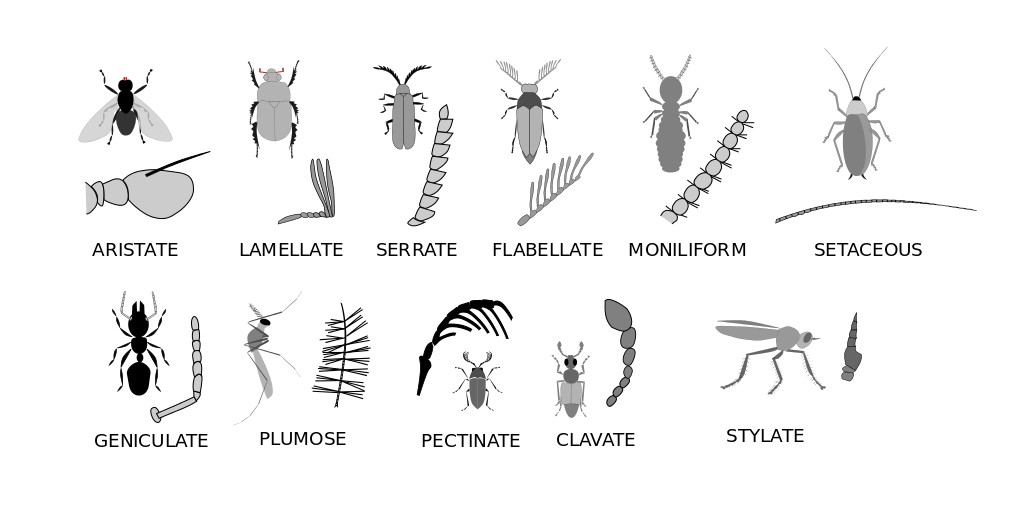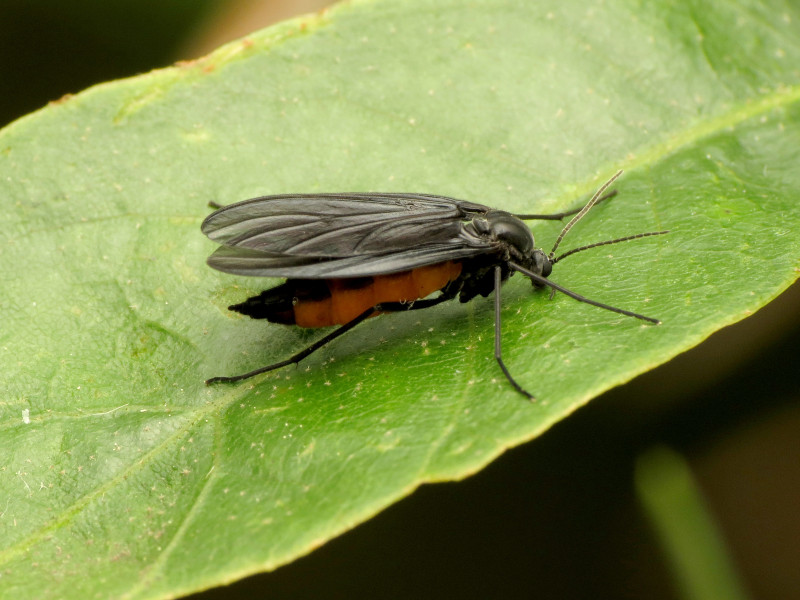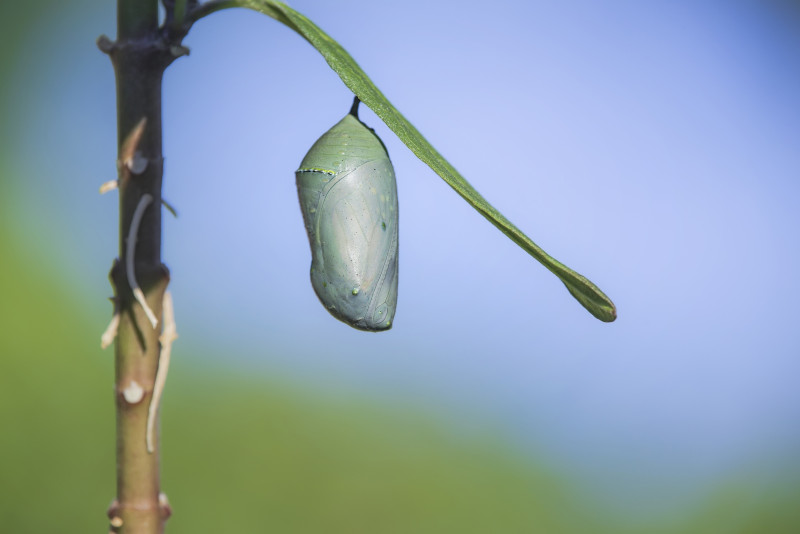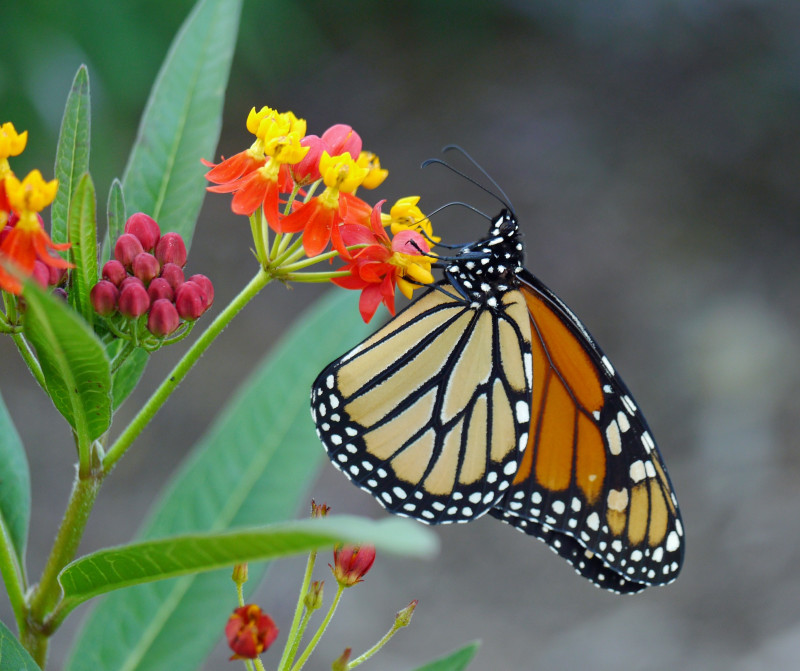Jump down to: Exoskeleton, Setae, Coloration • Senses, Pheromones • Head, Brain • Eyes, Hearing • Antennae, Mouth • Thorax, Legs, Wings • Abdomen, Circulation, Respiration, Digestion • Reproduction, Cerci • Anatomy at immature stage
Note: This page describes the anatomy of insects, not spiders. Insects belong to Class Insecta. Spiders belong to Class Arachnida—there’s a thorough article about them here.
There are a million identified insect species in the world, and you’ve seen lots of them “in person.” Have you ever wondered what makes them tick? Literally: Do they have a heart? And, what about a brain? How do they ingest food? What’s with their “buggy” eyes? Do they poop? You’ll find those answers here, and more. So, here we go:
First of all, there’s at least one exception to nearly everything that can be said about insects and their anatomy. But, no matter how much they may vary, they all have these three things in common:
Exoskeleton
The exoskeleton, sometimes called the cuticle, covers the entire outer body of an insect; there’s no interior skeleton. Made of a polysaccharide derived from glucose, and called chitin, it protects a completely soft interior. The chitin can be firm or yielding, depending on its thickness. So, while an insect’s face and legs have thin layers to allow flexibility, other parts of the exoskeleton are thicker and more protective.
Setae
Setae (sing. seta), cover the entire body of most species. They often look like hair, but are actually chitin, like the rest of the insect’s exoskeleton, and can take several forms, including hairy-looking, bristly, and spiny. Setae may also be widened and flattened into scales, like those on the wings of butterflies and moths. Most setae are attached to tiny organs that sense feel and touch, and their length and density varies—from long and thick, like a bumblebee’s, to bald-looking (to our eyes, anyway), like an ant’s body.
The setae on some water insects are formed to trap air bubbles for breathing underwater, and others have fine setae around their mouthparts for trapping water-borne food particles. Digging insects have stout, non-sensory setae aligned in rows on their legs. Some caterpillars have setae modified to trap organic materials on their body to use as camouflage, and there are others that have venomous spines or urticating hairs (irritating to the skin) as a defense mechanism.

Southern Flannel Moth caterpillar (or puss caterpillar), Megalopyge opercularis. Cute, but don’t touch! There are venomous spines hidden under those soft, fluffy “hairs” that cause severe pain. (© Brett Hondow / Shuttterstock)
Coloration
Insects produce colors in nearly every hue imaginable, sometimes in spectacular fashion, like some of the scarab beetles and butterflies. The colors are produced in several different ways:
Some are the result of ordinary pigments, mainly melanin, which don’t change. But others result from light waves that refract (bend) after striking microscopic ridges and layers in an insect’s exoskeleton (like light through a prism). Colors also are produced when they reflect a light wave directly back to its source without bending it.

Iridescence at its finest! Jewel beetle, Chrysochroa fulminans nishiyamai (© Mark Brandon / Shutterstock)
Some insects are iridescent. Iridescence occurs when overlapping scales produce peaks and valleys: Light waves striking them interfere with each other by either combining or canceling each other out, and the colors change as our angle of view or the light source changes.

Animation of visible light refracting in a prism. Visible light always contains red, orange, yellow, green, blue, indigo, and violet. (Lucas V. Barbosa / Wiki; PD)
Senses
Most insects have five senses, but they don’t detect stimuli in the same way humans do. For instance, they don’t have an actual nose, but they do have sensory organs all over their body that serve the same purpose. Insects can:
- See, using compound eyes for visual resolution, and ocelli for light detection.
- “Hear” through the movement of receptor-connected setae that respond to sound waves vibrating across them, and with sensory organs on their antennae. A few species have tympanic organs, like eardrums.
- Touch when they use their antennae as “feelers,” as well as feel it when their setae are being touched.
- Taste with setae located on their antennae, legs, and other body parts.
- Smell with receptors on their antennae and mouthparts that can distinguish the differences between thousands of chemical compounds.
Pheromones
A means of communication among insects is with organic compounds called pheromones (scents). They’re messages that elicit responses from other members of the same species: there’s food over here; come mate with me; stay away from my eggs; help me fight this predator; flee; and more. The pheromones are released through glands located in several places in the body and are attached to external ducts. They may be released into the air or secreted onto the ground or other surfaces.
Sex pheromones are most often used by females to attract males. Social insects, such as ants, lay a pheromone food trail between a discovered food source and the insect’s nest. Alarm pheromones are emitted by insects in response to danger. Some species release unpleasant pheromones into the air when threatened by a predator, or emit scents that incite aggression in others of their kind (an angry hive of honeybees, for example). Some females leave a territorial scent to mark the location of their eggs. Among social insects—all ants and termites, and some bees and wasps—pheromones govern almost every aspect of nest behavior.
Head
The head contains the brain, eyes, antennae, and mouthparts.
Brain
The brain, tiny as it is, can process myriad bits of input, and direct actions to the rest of the body. And, it has a human-like mid-brain structure (although more basic) that demonstrates levels of consciousness! Research suggests that they probably don’t feel grief or jealousy, but they may feel something like hunger and pain, and perhaps a sort of anger.
And, there’s more: The lowly fruit fly, a favorite subject of research, which has a brain the size of a poppy seed, with 100,000 neurons (humans have 100 billion) can gather information and make decisions before it acts. That’s considered to be a sign of higher intelligence. Amazing!
And, there are even smarter insects: Bees, ants, and termites, all of which live in social communities and share information, are insect geniuses. Honeybee studies show they can recognize and distinguish between human faces, count, learn and problem-solve, and “waggle dance” to communicate to others the direction and distance to a nectar source. All about honeybees
Eyes
Most adult insects have two large compound eyes. They’re comprised of hundreds or even thousands of tiny lenses. Each lens (ommatidium) is connected to an optic nerve and faces a single direction, one that’s just a tad different from all the others. The brain receives and interprets visual input from all of them to form a complete picture.
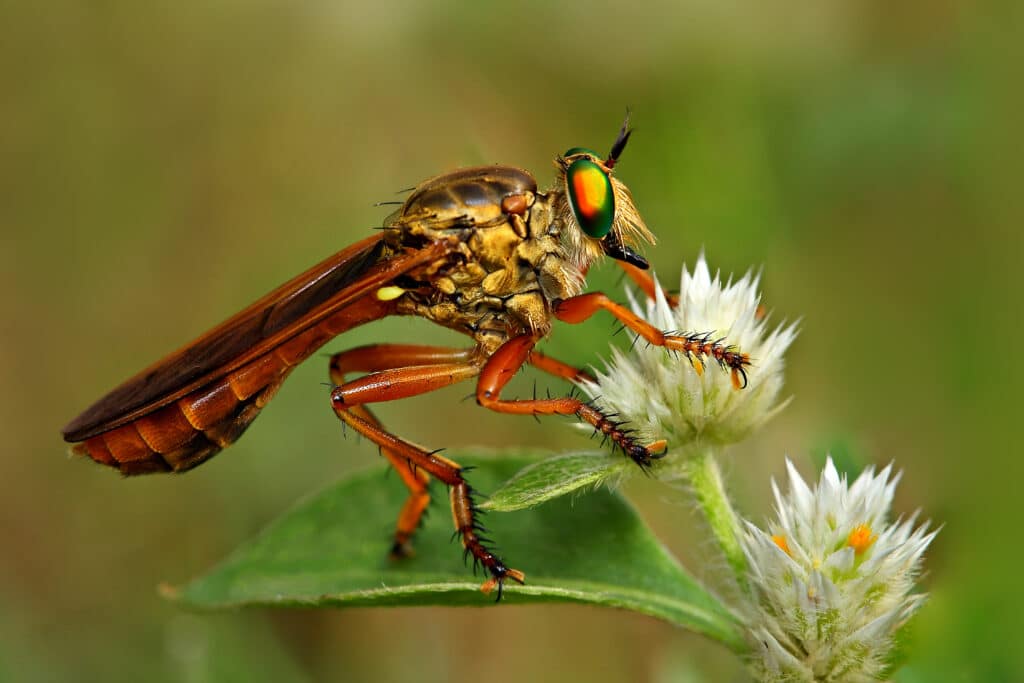
Normally dark, the compound eyes of a robber fly (family Asilidae) are beautifully reflective when light strikes them. (© Seema Swami / Shutterstock)
Compound eyes are usually located at the sides of the head, with some so large they touch each other in the middle, or nearly so. There’s a small group of unique flies (Family Diopsidae) inhabiting Southern Africa and Southeast Asia with their compound eyes (and their antennae) located at the ends of two stalks that project from the front of their head!
Black and shades of brown are common eye colors, but those of the fruit fly are bright red. The Green-eyed Flower Bee, Anthophora bimaculata, has . . . well, you can guess! Many insects, including robber flies and dragonflies, whose eyes are normally dark, flash with brilliant colors when caught in the light.
The structure of compound eyes was thought to result in blurry vision, until researchers at the University of Sheffield, in England, made a surprising discovery: They found tiny photoreceptor cells (which are associated with the retina) just beneath each ommatidium in fruit flies. The cells rapidly move in and out of focus and, combined with normal head movements, produce a much sharper image than previously thought.1
Simple eyes
In addition to their compound eyes, all adult insects have two or three tiny “simple eyes,” called ocelli (oh-CELL-ee). They have only one lens each, and can’t focus. Located at the top or front of the head (the position varies), their job is to detect the intensity of light and dark. Immature insects—known variously as nymphs, caterpillars, naiads, larvae—lack compound eyes, but they do have ocelli. That means, for example, that the butterfly caterpillar on your plant can’t discern your form, but it can detect the shadow you cast.

Face of a cicada (Cicadoidea) that has just shed its old skin. Notice the compound eyes on each of its head, and the three red ocelli in the center. (© manatus / Shutterstock)
Hearing
Insects don’t have ears, but that doesn’t mean they can’t “hear,” in their own way. Sound waves create vibrations, and insects can detect them through sensory organs attached to stiff hairs scattered here and there on their body. Some species also have these organs on their antennae. A few, including cicadas, grasshoppers, and moths, have a thin tympanic organ (eardrum) on each side of their body: located at the surface, they vibrate, like our own eardrums, in response to sound waves. In every case, the inset’s brain analyses the “sound” to distinguish mating calls, predators, prey, distance away, speed, and other information.
Antennae
The head has two antennae (an-TEN-ee), with three (some flies) up to 140 (cockroaches) muscled segments. The antennae (singular: antenna) serve as primary sense organs for smell, taste, touch, temperature, humidity, and pressure. They’re flexible and highly varied: long, short or stubby, feathery, bristly, thin, straight, or hair-like. Some even resemble a string of beads.
Mouth
There are five basic components—mandibles and maxillae (jaws), labium and labrum (lips), and hypopharynx (tongue-like)—of an insect’s mouth. However, they vary so much in size, form, and function among groups, it’s more accurate to use the term mouthparts. Some mouthparts are designed for chewing, others are modified for sucking, or piercing, or sponging—it all depends on an insect’s method of ingesting food. Some insects also have appendages called palps attached to their labium; they’re finger-like and used to manipulate food.
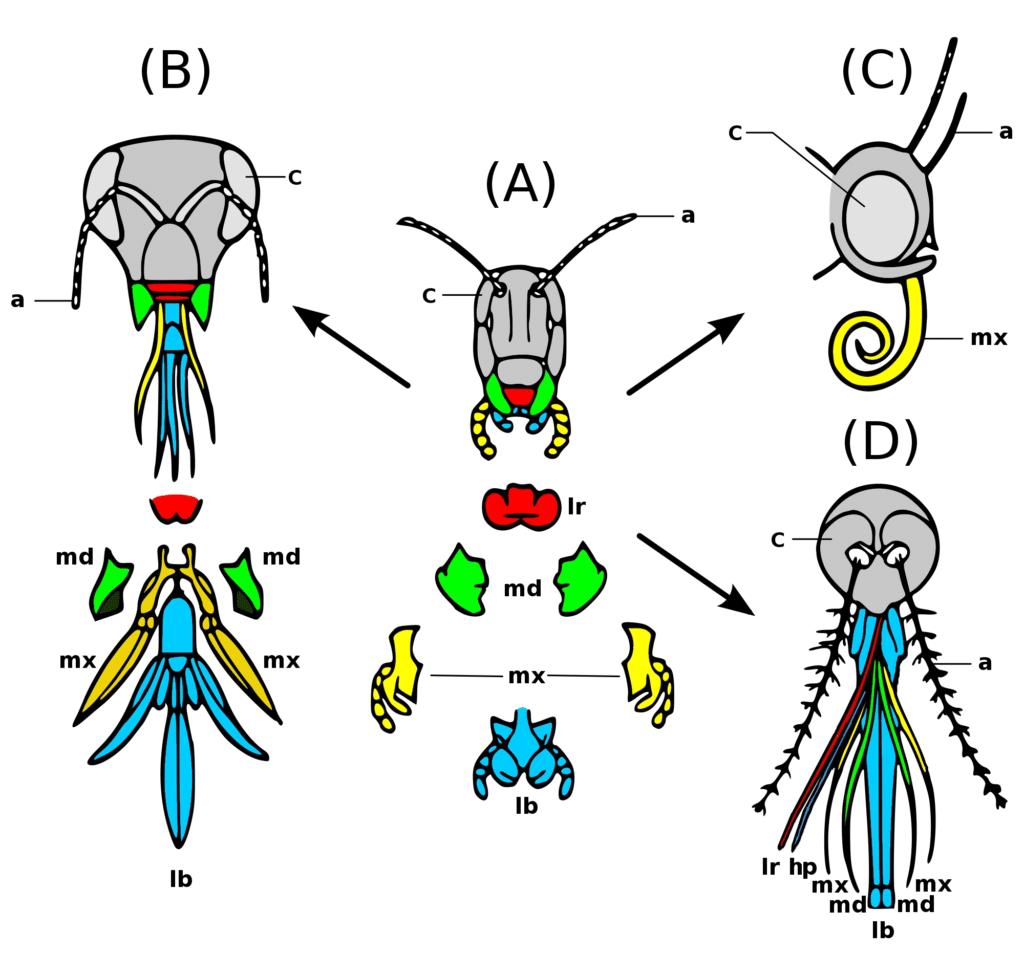
The development of insect mouthparts from the primitive chewing mouthparts of a grasshopper in the center (A), to the lapping type (B) of a bee, the sucking type (C) of a butterfly, and the sucking type (D) of a female mosquito. Legend—a: antennae; c: compound eye; lb: labium; lr: labrum; md: mandibles; mx: maxillae; hp: hypopharynx. (Color derivative by Siga / Wiki; original by Xavier Vázquez; CC BY-SA 3.0)
One group of insects is aptly named for its novel use for the mouth: In the summer, if a blowfly’s body gets too hot for comfort, it uses saliva to blow a bubble. Research has shown that as the bubble begins to evaporate in the air, it cools down; when the fly re-ingests it, its body temperature drops, too. The flies sometimes do this repeatedly on very hot days.
Examples of how insects consume their food: Dragonflies chew their food, female mosquitoes pierce skin with a sharp proboscis to suck blood, and most flies have a sponge-like organ for sopping up liquids. Butterflies chew their food when they’re larvae, but suck liquid foods as adults. (Some insect species, like most moths, don’t eat at all during their adult stage.)
Thorax
The middle part of the insect’s body, the thorax is comprised of three segments (prothorax, mesothorax, metathorax), which can usually be distinguished. Three pairs of legs and (usually) two pairs of wings are attached to it. Spiracles, which are openings for air intake, are usually present, too (more about them later).

Insect’s main body parts: A- Head B- Thorax C- Abdomen 1. antenna 2. ocelli (lower) 3. ocelli (upper) 4. compound eye 5. brain (cerebral ganglia) 6. prothorax 7. dorsal artery 8. spiracles attached to trachea; typically two pairs in the thorax, up to four pairs in the abdomen) 9. mesothorax 10. metathorax 11. first wing 12. second wing 13. mid-gut (stomach) 14. heart 15. ovary 16. hind-gut (intestine, rectum & anus) 17. anus 18. oviduct 19. nerve chord (abdominal ganglia) 20. Malpighian tubes (excretory organ) 21. pillow (pad between claws) 22. claws 23. tarsus 24. tibia 25. femur 26. trochanter 27. foregut (crop, gizzard) 28. thoracic ganglion (neurons) 29. coxa 30. salivary gland 31. subesophageal ganglion 32. mouthparts. (Piotr Jaworski / Wiki; cc by-sa 3.0)
Legs
In adults, one pair of legs is attached to each segment of the thorax (many larvae are caterpillar or worm-like, and don’t have true legs). The legs are jointed and have a coxa (hipbone), trochanter (muscles from the femur attach to it), femur (thigh bone), tibia (shinbone), and tarsus (below the shinbone). Each leg usually ends in a claw (that sometimes is equipped with an adhesive pad). The legs also have sensory organs that taste foods by interpreting their chemical properties.
When walking, insects usually move three legs at a time—the front and back legs on one side and the middle leg on the opposite side—to help maintain balance. Their legs aren’t just for walking, though: they may also be called on for jumping (crickets, grasshoppers, others), catching prey (dragonflies, others), burrowing (solitary bees, ants, others), or swimming (whirligig beetles, others). All about dragonflies
Many have modified legs to be used for other purposes, too. Some examples: Honeybees can use their hind legs for storing pollen to be carried back to the hive. Water striders have paddle-shaped legs. Digging insects, like some bumblebees, have strong front legs shaped something like shovels, and crickets and other jumping insects have large, powerful back legs. And, katydids are among those that produce “songs” by rubbing their hind legs together.
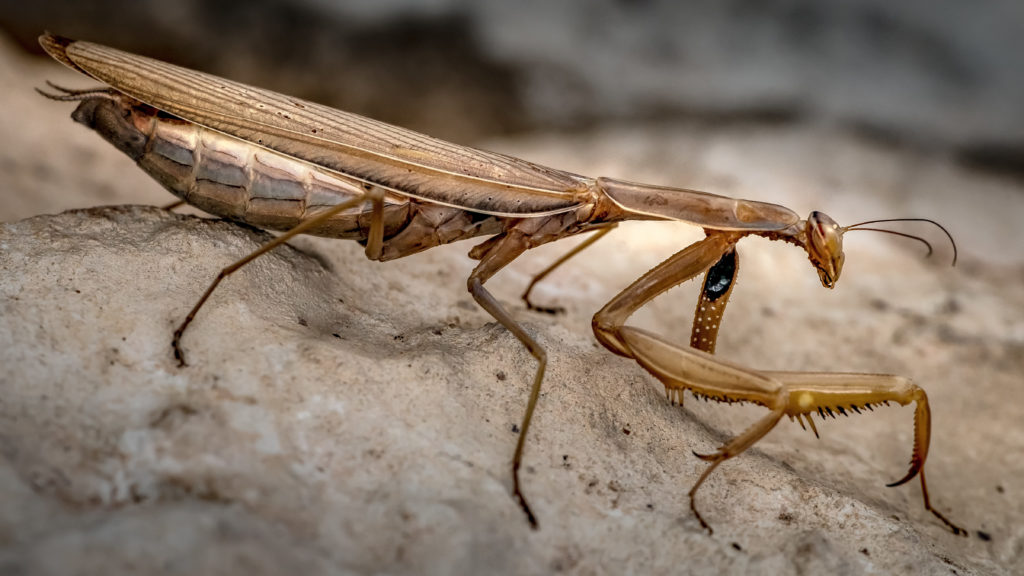
Praying Mantis (Mantis religiosa). Each pair of legs is attached to a different segment of the thorax. Its wings are lying flat atop the abdomen. (Bernd Thaller / Flickr; cc by 2.0)
Wings
Wings are made of chitin, the same natural material that makes up the exoskeleton. Almost all adult insects have two pairs of (not always visible) wings attached to the thorax—one to the second segment and the other to the third. Wings are usually thin and are given structural support by the many rigid veins that run through them. A muscular hinge joins them to the thorax and provides the range of motion and strength they need for flight.
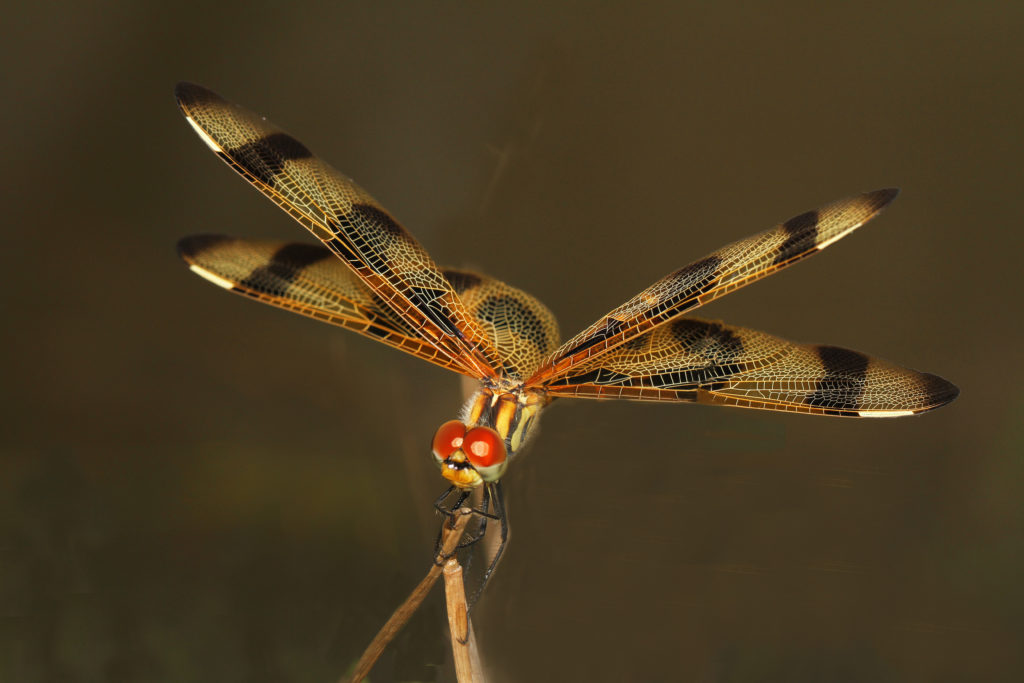
Halloween Pennant Dragonfly, Celithemis eponina. Notice the structural intricacy of its wings. (Judy Gallagher / Flickr; CC BY 2.0)
Adult flies are the only insects that don’t have two pairs of wings—they have a front pair only. The hind wings are modified into halteres (HALL-tiers), little nubs that act as flight stabilizers. The only adult insects that truly lack wings are fleas, lice, silverfish, firebrats, and small groups of various other little-known insects.
Beetles and some true bugs, unlike other insects, have hardened forewings called elytra (ELLA-truh), which are designed to protect their delicate hind wings, which do all the flying. (The photo at top of this page shows a lady beetle’s raised elytra.) Other insects, including some dragonflies, grasshoppers, and butterflies, have wings that are transparent, but may also have colors and patterns. All about true bugs
Abdomen
The abdomen is usually the largest part of an insect’s body. It’s formed of flexible segments, typically 11 or 12, and contains the rearmost parts of the circulatory, nervous and digestive systems, as well as the excretory and reproductive systems.
Circulatory system
An insect’s “heart,” (dorsal vessel) is tube-like and long—which is a relative term, because “long” in a fly, for example, is only 0.04 inches (1 mm). The heart doesn’t transport oxygen, as in humans, but it does pulse in response to body movement and pumps nutrient-rich insect blood (hemolymph) to the cells and removes waste products.
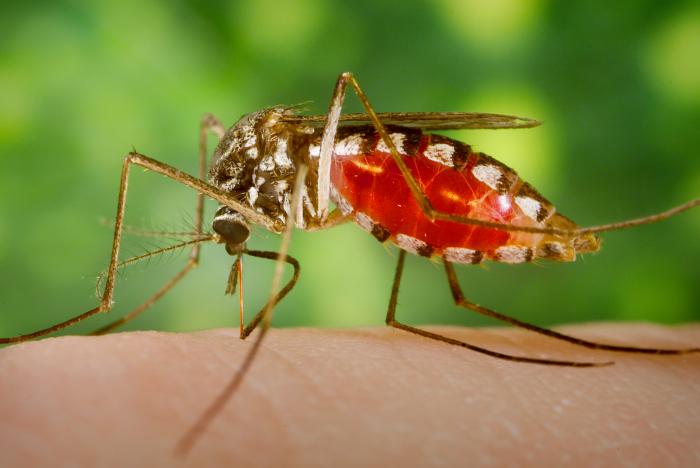
The blood of a human volunteer can be seen filling the abdomen of this mosquito, Armigeres subalbatus, as she feeds. If she gets smashed, she’ll appear to have red blood. (James Gathany, CDC; PD)
Insects don’t lack only a heart, but arteries, too. The dorsal vessel pumps blood forward to the front of the body and releases it. From there, it flows freely backward through the thorax and into the abdomen, with no constrictions. Along the way, it bathes all the organs in nutrients, while taking up waste products. It circulates round and round like this in a passive process called rhythmic tracheal compression. Insect blood, by the way, isn’t red—it’s greenish, yellowish, or clear. (Human blood is red because it contains iron, which reacts to oxygen by turning red.)
Respiration
Like us, insects can’t survive without oxygen. But along with the heart and arteries, they also lack lungs. Instead, they get their air through spiracles, which are tiny pores along each side of their body, usually one pair per segment. Different orders of insects have a different number of them, but no adult has more than ten pairs. These spiracles are connected to tracheal tubes that get smaller and smaller and feed oxygen to every cell, while picking up carbon dioxide to be dispelled from the body.
Through muscular action, insects can force air in through their spiracles. But, there’s a physical limit to their tracheal system, and that prevents them from getting the amount of oxygen they would need to grow larger than they are. That’s why we don’t have foot-long wasps flying around our yards! Whew!
As for water insects, some breathe by way of gills filled with air tubes and get their oxygen from the water, just like fish. Others go to the surface and grab an air bubble, which they carry under their wings or abdomen.
Digestive system
Insects poop! Their digestive system, called the alimentary canal, is one long coiled tube that extends from the insect’s mouth to its anus. It has three major regions: the foregut, midgut, and hindgut. As food moves through the system, nutrients are extracted and passed through semi-permeable membranes into the hemolymph, for use by the body’s cells. Meanwhile, at the end of the hindgut, there are “Malpighian tubes” that absorb waste products from the hemolymph, and they’ll be compressed in the rectum and eliminated.
Reproductive system
Females have a vagina and a pair of ovaries that produce eggs. Males have a complex organ called an aedeagus (e-d-A-gus) that functions like a penis. Most insects copulate as you might imagine: the male inserts his organ into the female’s genitalia. Researchers have discovered that male fruit flies feel pleasure when they ejaculate, but it isn’t known whether other insects do.2
Fertilized eggs exit the female’s body through a tube-like organ called an ovipositor. In the case of bees and wasps, this organ is modified—it’s connected to a venom gland and can be used as a stinger. Honeybees, wasps, some ants, and others are well known for theirs!

The sting of a Red Paper Wasp, Polistes carolina, under high magnification. (Insects Unlocked / Flickr; PD)
Cerci
Many insects have two appendages at the tip of their abdomen called cerci. They may be long (even conspicuous) or short, and are usually segmented and jointed. Most of the time, they serve one of three purposes: as sensory organs, as graspers used during copulation, or as weapons used for pinching. They’re a mystery in some species—scientists haven’t yet figured out their use and believe they may simply be vestigial structures that have lost their original purpose.
Anatomy of immature insects
The life cycle of an insect involves either complete metamorphosis (holometabolism), incomplete metamorphosis (hemimetabolism), or no metamorphosis (ametabolism).
Complete metamorphosis means the insect progresses from egg to larva to pupa to adult. The immature and adult stages are anatomically different from each other. Some examples are the maggots, grubs, and caterpillars of flies, beetles, and butterflies—their organs are rudimentary and mature during the pupal stage into adult form.
The larvae of insects that undergo incomplete metamorphosis, on the other hand, are similar in form to the adults they’ll become; they just differ in size, body proportion, and color. They have compound eyes, developed legs, and wing stubs that can be seen. By the time they shed their exoskeleton for the final time (molt), their wings and sex organs are fully developed. Examples of these insects are cicadas, grasshoppers, crickets, and praying mantises.
The third type of development, ametabolism, affects only one species, Silverfish, Lepisma saccharina. They just hatch and grow up, with little to no change in form.
———————————————————
| 1 Sheffield.ac.uk, Sept., 5, 2017: Insects can see the world in much finer resolution than previously thought |
| 2 Conducted by Galit Shohat-Ophir and others, of Bar-Ilan University in Ramat Gan, Israel, and reported by Andy Coghaln, New Scientist.com, April 19, 2018: Male fruit flies feel pleasure when they ejaculate |
| *Top image: Seven-spotted Lady Beetle facing the camera with wings raised. (© Cornel Constantin / Shutterstock) |




